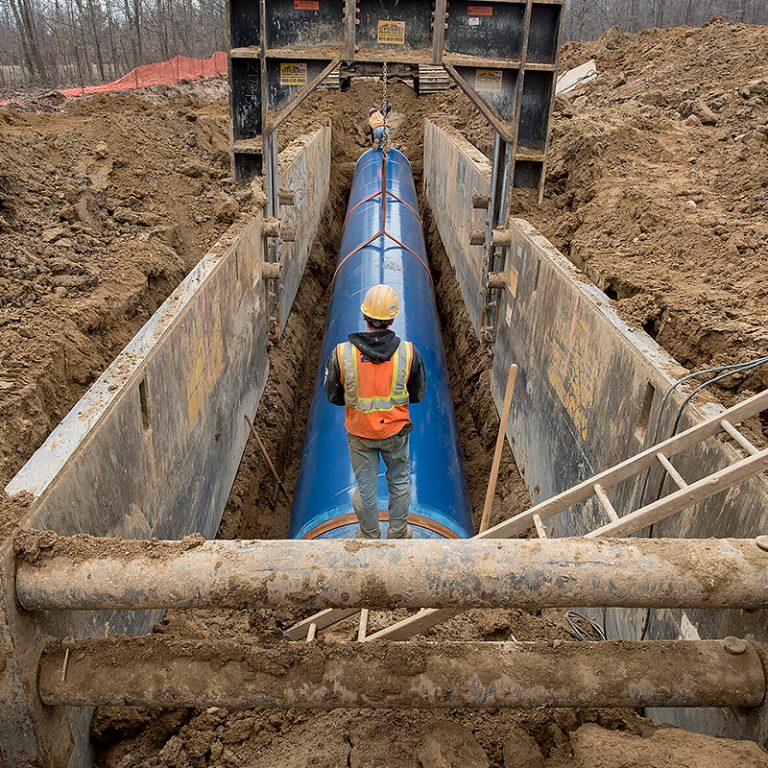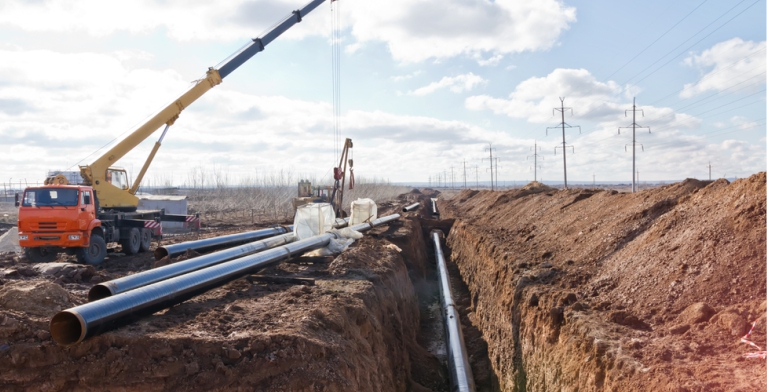The Importance of Long-Term Performance With Creek Pipe HDPE installation
A Deep Dive Into Pipes Installation: Important Factors and Factors To Consider for Successful Projects
Effective pipe installation is a vital element of engineering tasks. It includes a variety of aspects, from product selection to specific sizing and design. Each choice can notably affect the system's performance and longevity. Recognizing these parts is necessary for avoiding expensive blunders. Creek Pipe reviews. As groups navigate through the complexities of installation, numerous key considerations emerge that warrant focus. What are the critical aspects that can make or damage a piping task?
Understanding Pipe Materials and Their Applications
When choosing pipe products, one have to consider the details applications and ecological conditions they will certainly encounter. Various products offer distinctive residential or commercial properties that satisfy numerous demands. PVC is lightweight and immune to deterioration, making it ideal for water distribution systems. Conversely, steel pipes offer strength and toughness, appropriate for high-pressure applications yet might need safety coatings to stop rust.Copper pipes are favored for plumbing due to their antimicrobial homes and simplicity of installation, while polyethylene is frequently utilized in underground applications due to its adaptability and resistance to cracking.The selection of product additionally rests on temperature level extremes, chemical direct exposure, and installation place. For high-temperature applications, materials like CPVC or PEX can be helpful. Eventually, comprehending the attributes and restrictions of each product help in making notified decisions that boost system performance and long life.
Significance of Proper Sizing and Style
Appropriate sizing and design of pipelines are important for making certain suitable circulation prices and reducing pressure loss. These factors additionally play a considerable role in figuring out the compatibility of materials used in the installation. An organized strategy to sizing and style can substantially improve the efficiency and long life of a piping system.
Effect On Flow Rates
Flow prices in piping systems are critically affected by the sizing and style of the pipes. Appropriately sized pipes assure that the liquid can move effectively, minimizing turbulence and taking full advantage of circulation capacity. Large pipelines can bring about minimized circulation velocities, while undersized pipes might restrict circulation, causing boosted rubbing and possible obstructions. The layout needs to likewise think about variables such as pipe product, interior surface level of smoothness, and design, as these add to the overall effectiveness of fluid transport. Furthermore, the plan of installations and links within the system can influence circulation prices. Consequently, precise interest to pipe sizing and style is important for maximizing circulation efficiency in any piping installation project.
Stress Loss Factors To Consider

How can push loss greatly influence the effectiveness of a piping system? Pressure loss is a critical factor that can substantially decrease the efficiency of liquid transport systems. When pipelines are improperly sized or made, excessive stress loss may take place, resulting in lowered circulation prices and boosted power usage. This inefficiency can result in greater operational prices and prospective system failings. Appropriate sizing and design are crucial to lessen stress loss, making sure that liquid dynamics continue to be perfect throughout the system. Engineers have to thoroughly take into consideration elements such as pipe size, size, and material to accomplish an efficient equilibrium. Eventually, resolving pressure loss during the style stage can enhance dependability and longevity, making it crucial for successful piping jobs.
Product Compatibility Factors
Pressure loss is not the only element that can affect the efficiency of a piping system; material compatibility additionally plays a considerable duty in total efficiency. Guaranteeing that the products used in a piping system are compatible with the fluids they will certainly move is important. Different materials can react adversely to different chemicals, bring about deterioration, destruction, or contamination. This can inevitably compromise the integrity of the system and affect its longevity. Furthermore, correct sizing and layout are vital to suit thermal development and tightening, which can additionally affect product performance. Assessing elements such as temperature, pressure, and chemical make-up is crucial in selecting suitable materials, consequently boosting system integrity and lowering upkeep expenses in the lengthy term.
Techniques for Accurate Pipe Installation
Exact pipe installation is important for assuring system effectiveness and longevity. A number of techniques can improve the accuracy of this procedure. First, mindful measurement is crucial; installers ought to make use of quality devices such as laser levels and tape steps to establish the precise sizes and angles required. Next, appropriate pipe reducing strategies, like using a pipe cutter as opposed to a hacksaw, assurance tidy sides that help with much better links. In addition, using positioning devices, such as pipe jigs, can significantly boost precision during assembly. It is also a good idea to consider thermal development; enabling adequate spacing and expansion joints can avoid future misalignments. Lastly, the installation team must comply with maker standards to comply with certain suggestions associated with each pipe type. By carrying out these methods, the probability of leaks and system failings lowers, inevitably adding to a much more trusted piping system.
Making Certain Pipe Placement and Support
Proper placement and assistance are important to the stability and performance of any kind of piping system. Misalignment can lead to raised stress and anxiety on joints, possible leaks, and reduced performance. To ensure proper placement, it is important to use appropriate go devices such as laser levels and placement evaluates. These tools assist achieve exact positioning, assuring that pipelines are installed according to layout specifications.Support systems must be designed to fit thermal expansion and tightening, along with the weight of the pipes and their materials. Choosing the right kind of assistances, hangers, and braces is necessary. Each ought to be mounted at specified intervals to stop sagging or excessive stress on the pipelines. Normal evaluations following installation can assist recognize any imbalances or indicators of inadequate support. By focusing on placement and assistance, one can significantly boost the resilience and performance of the piping system.
Usual Installation Blunders to Avoid

Testing and Inspection for Quality Control
Although the installation process might appear complete, thorough screening and evaluation are crucial to ensuring the lasting integrity of a piping system. Various techniques are employed to evaluate the stability of the installation, including pressure examinations, aesthetic assessments, and non-destructive screening (NDT) methods. Stress tests confirm that the system can withstand operational problems without leakages, while visual assessments aid identify any type of noticeable defects in the pipes or joints. NDT techniques, such as ultrasonic or radiographic screening, provide insights right into the product honesty without compromising the system.Additionally, documenting the screening results is necessary for future reference and compliance with industry requirements. This documents offers not just as a quality control step but likewise as a legal secure. Inevitably, a comprehensive testing and assessment method adds to the total security and effectiveness of the piping system, guaranteeing it satisfies the necessary efficiency requirements gradually.
Upkeep Tips for Resilient Pipe Solutions
Keeping a pipe system needs normal assessments and monitoring to identify potential concerns prior to they intensify. Applying reliable cleansing methods is likewise important for preventing build-up that can hinder efficiency. With each other, these techniques add to the durability and reliability of the piping infrastructure.
Normal Assessments and Tracking
Regular examinations and tracking wheeled excavator are important for ensuring the long life and effectiveness of pipe systems. Regular analyses can assist identify prospective issues such as leakages, corrosion, or clogs before they rise into substantial issues. Implementing a timetable for routine assessments enables the early discovery of deterioration, enabling timely fixings. Tracking stress levels and circulation prices can likewise give important understandings into system performance, making certain that any abnormalities are addressed immediately. In addition, the use of sophisticated technologies, such as infrared video cameras or ultrasonic screening, can boost the evaluation process by giving detailed info regarding pipe problems. Inevitably, consistent tracking and examinations add to the reliability and toughness of pipe systems, reducing the risk of costly repair work and downtime.

Effective Cleaning Methods
Efficient cleansing techniques are vital for preserving the honesty and capability of pipe systems. Regularly scheduled maintenance, such as flushing systems with water, helps remove debris and buildup. For more stubborn discover this obstructions, experts commonly suggest hydro jetting, which utilizes high-pressure water to clean pipe interiors thoroughly. Chemical cleaners can also be utilized but should be chosen carefully to avoid destructive pipelines. In enhancement, utilizing tools like pipe video cameras can aid in identifying issue areas and guaranteeing effective cleansing. Keeping appropriate drain and avoiding the disposal of hazardous substances down pipelines further add to long life. Generally, constant cleaning techniques not just boost performance but also reduce the threat of expensive repair services in the future.
Frequently Asked Concerns
What Are the Labor Expenses Connected With Pipe Installation Projects?
Labor costs for pipe installation projects differ widely, influenced by variables like job intricacy, neighborhood wage prices, and called for skills (Creek Pipe trenching services). Normally, these costs can vary from $50 to $100 per hour, depending on the labor force involved
Exactly How Do Neighborhood Rules Affect Pipe Installation Practices?
Local laws considerably affect pipe installation practices by developing safety and security requirements, product specifications, and installation techniques. Conformity with these policies warranties task security, ecological defense, and adherence to local codes, eventually influencing overall job success and prices.
What Tools Are Crucial for Pipe Installation?
Essential tools for pipe installation include monkey wrench, cutters, and installations. In addition, sealants, determining tapes, and degrees ensure accuracy and resilience. Correct equipment promotes effectiveness and adherence to security criteria throughout the installation procedure.
How Can Weather Condition Conditions Influence the Installation Refine?
Climate condition considerably influence the installation procedure, as severe temperatures, rainfall, or wind can influence material integrity, worker safety, and project timelines. Proper planning and scheduling are important to reduce these potential challenges throughout installation.
Exist Guarantees for Set Up Pipe Systems?
Warranties for mounted pipe systems usually differ by maker and installation specialist. Usually, they cover problems and workmanship for a specific duration, making sure the system's dependability and providing satisfaction to the homeowner.